Papers by Van Voulgarakis

Confronting “Linguistic Genocide”: Language Repression in Kurdistan
Globalization and Human Rights in the Developing World, 2011
Language, along with ethnicity or religion, is widely regarded as a core aspect of personal and g... more Language, along with ethnicity or religion, is widely regarded as a core aspect of personal and group identity. Just as it would be monstrous to force someone to renounce their religion, and absurd to expect them to change ethnicity, so too must an individual’s language receive respect, we are told, lest its oppressors stand revealed as the moral equivalent of Nazis. Yet compromises do occur—new languages are learned, old ones are neglected, conversions take place, and even ethnicity is subject to a certain amount of renegotiation and contextualization. We might expect to find language rights violations concentrated in the developing world, where human rights in general tend to be least respected. A peculiarity of the literature on language rights, however, is that, as often as not, the countries which it targets are relatively progressive ones with strong traditions of democracy and human rights. A number of writers use terms like “linguistic genocide” or “linguicide” (we shall treat them as synonyms) for policies that encourage language shift or language death. It is a point of continuing debate whether “genocide” necessarily involves mass murder, or whether attempts merely to disband or assimilate an identity group—without killing its people—might also qualify. Tove Skutnabb-Kangas and her husband, Robert Phillipson produce studies to argue that the denial of mother-tongue education qualifies as “serious . . . mental harm.” To the extent that the concept of “linguistic genocide” is at all legitimate or useful—we are not convinced that it is—the experience of the Kurds would surely qualify as a preeminent example. This unavoidable vagueness of group identity turns out to pose a major difficulty to the concept of linguistic genocide.
Mary, Athena, and Kuan-yin: What the Church, the Demos, and the Sangha Can Teach Us about Religious Pluralism and Doctrinal Conformity to Socio-cultural …
Asia Journal of Global Studies: Vol. 3, Nos. 1 …, 2010
Page 85. Asia Journal of Global Studies Vol 3, No 2 (2010), 72-92 Mary, Athena, and Kuan-yin: Wha... more Page 85. Asia Journal of Global Studies Vol 3, No 2 (2010), 72-92 Mary, Athena, and Kuan-yin: What the Church, the Demos, and the Sangha Can Teach Us about Religious Pluralism and Doctrinal Conformity to Socio-cultural ...
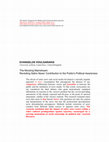
THE ASIAN CONGRESS OF MEDIA AND COMMUNICATION JOURNAL, 2020
The advent of satire news and social media developed a currently popular approach to news consump... more The advent of satire news and social media developed a currently popular approach to news consumption that presupposes the absence of any competence differential between viewer and journalist or between the public and the institution of news media. To that extent, newscasters are not considered the final arbiters who grant meticulously explained affirmation or rejection to the viewer's position but the service-oriented announcers of the already expected and obvious-to the point of satirical amusenent-validity of the viewer's outlook. Thus satire news caters to that biased viewer who questions not only the content and interpretation of the news but also the professional specialization news dissemination presupposes. This occurs within a wider cultural predisposition against expertise, encouraged by a growing momentum of social censorship on political and research discourse..
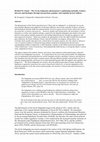
The phenomemon of the Greek Aganaktismenoi (" those who are indignant "), or Indignados (to use t... more The phenomemon of the Greek Aganaktismenoi (" those who are indignant "), or Indignados (to use the more familiar Spanish term) gathered to itself many different, and at times mutually exclusive, political and ideological elements under the common themes of protest against foreign lenders and protest against governmental corruption and austerity. However, despite such inclusiveness, the movement is viewed primarily as a leftist, anti-capitalist initiative, inspired by the Spanish Indignados and similar to the usual protest events against summits organized by the leading industrial powers, though less aggressive and more grassroots-oriented. When one considers the participation of the (far-right) Golden Dawn political party adherents, the Greek Orthodox Church, and anti-Orthodox neo-pagans, among others, one concludes fairly quickly that apart from a shared desire for media exposure, the only cohesive element is a set of common symbols of national heritage (despite antithetical interpretations thereof) and a corresponding attitude of superiority to other European countries on the dubious historical grounds that " Direct Democracy " (Amesi Demokratia), which purportedly holds the key to solving the nation's current crisis, originated in Greece. This paper examines the symbols, rhetoric, grievances, and conspiracy-related phraseology connected with the Greek Indignados movement. It is argued that in the eyes of the general public, the Indignados serve as legitimation and justification for various mutually-exclusive ideologies, interests, and objectives. The European crisis has provided a common enemy allowing different groups to present their activity as patriotic, popular/populist, anti-fascist (even ultra-nationalist groups make this appeal), anti-capitalist, and progressive. The Greek Indignados movement is thus the political equivalent of money laundering— legitimacy is gained by immersion into a pool of pan-Greek collectivity, so that the indignation of the protesters purports to echo that of the common people, the citizenry in whose name direct democracy is said to function.
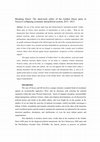
The rise of the extreme right wing and self-proclaimed " nationalist-socialist " Golden Dawn part... more The rise of the extreme right wing and self-proclaimed " nationalist-socialist " Golden Dawn party in Greece raises questions of nomenclature as well as ethics. What are the demarcation lines between nationalism and fascism, patriotism and chauvinism, activism and political terrorism, ethnic exclusivism and racism? Is it ethical for a political party with parliamentary representation to be almost unanimously depicted as a criminal organization, after an equally unanimous disregard of the official legal case file and of the ongoing judicial process? (Note that its leaders were arrested and taken handcuffed for questioning by anti-terrorist police units in front of the media, but not yet charged, in connection with a murder case) Is political violence ethical when directed against fascist organizations, irrespective of their constitutional support? This paper analyzes the treatment of Golden Dawn 1 by other political, social and media actors. Domestic discourse depicts Greece, on one hand, as a pluralist, tolerant, democratic Western country; and on the other, as a struggling, unfairly maligned, ethnically-diluted nation betrayed by enemies within and without. The rise and apparent fall of Golden Dawn reflect a national frustration with the failures of domestic leaders and international allies, as well as an equally potent desire to excuse " normal " forms of chauvinism and xenophobia by condemning the more directly hostile rhetoric and activity of the Golden Dawn. This ethical turn illustrates the impact of globalization.
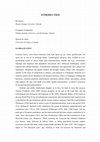
Centuries hence, when future historians look back upon our era, surely globalization will stand o... more Centuries hence, when future historians look back upon our era, surely globalization will stand out as one of its defining trends. Technological advances have resulted in ever-accelerating levels of travel, trade, and communication. Human ties (e.g., cross-border marriage and adoption) and population movements have followed, challenging various regional and cultural identities. Transnational institutions and agreements have gained new importance. Integration into global markets has brought routine contact with “foreigners,” whether in the form of competition or alliance, and imitation is widespread. Elements of a common culture can be identified in our business practices, choice of languages, clothing and hairstyles, consumer products, entertainment, education, military affairs, and politics, among other spheres. We may even speak of a certain “global consciousness,” a reflexive awareness of our growing interconnectedness.1
Scholars and public intellectuals disagree as to how far back to trace this process. Thomas Friedman (1999, 2005) focuses primarily on the end of the Cold War, and the technological and managerial developments of the 1990s. Benjamin Barber (1992) looks to the post-World War II rise of multinational corporations and international trade regimes (such as the Bretton Woods institutions and the various common markets). Paul Hirst and Grahame Thompson (1996) liken this to earlier cycles of internationalization, such as the period 1870-1914. William H. McNeill (1963) emphasizes the period of European industrialization and colonialism from 1750 to 1950. Immanuel Wallerstein (1974, 1980, 1989) begins with the great age of European exploration, and the intercontinental maritime empires established in its wake. Janet Abu-Lughod (1991) and Jack Weatherford (2004) hail the contributions of the thirteenth-century pax Mongolica. Others nominate the Umayyad and Abbasid Caliphates (e.g. Stearns, Adas, Schwartz & Gilbert, 2004), or earlier land-based Eurasian empires associated with the Silk Road. Andre Gunder Frank and Barry K. Gills (1991, 1993) suggest a figure of “five thousand years” ago, referring to trade ties between the Sumerian and Harappan civilizations. Daniel Quinn (1992) and Jared Diamond (1997) point to the development of mass agriculture some 10,000 years ago. Finally, James Harrod (2006) refers to “periods of globalization” during the Lower Paleolithic, between 1.9 and 1.6 million years ago, in which Olduwan industries (and presumably also the hominins themselves) spread out of Africa across Asia via the Indian Ocean.
Of course there is some merit to each of these starting points, at least within specifically defined contexts, and numerous attempts at periodization (some by the same authors). Here we may usefully resort to David Held’s distinction between “thick” globalization (characterized by high extensity, intensity, velocity, and impact) and several earlier forms. For example, the ancient Silk Road (which combined high extensity with low intensity, velocity, and impact) would be an example of “thin” globalization (Held, McGrew, Goldblatt, and Perraton, 1999; see also Nye, 2002). At any rate, the present momentum – for better or worse, and regardless of the system’s ultimate success or failure – is clearly in the direction of thickness. Less amenable to reconciliation are the questions of whether our era is unique, or part of some larger economic or historical cycle; and whether neoliberal economic policies will, or should, prevail under the New World Order.
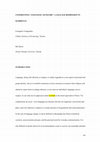
Globalization and Human Rights in the Developing World, 2011
Language, along with ethnicity or religion, is widely regarded as a core aspect of personal and g... more Language, along with ethnicity or religion, is widely regarded as a core aspect of personal and group identity. Just as it would be monstrous to force someone to renounce their religion, and absurd to expect them to change ethnicity, so too must an individual’s language receive respect, we are told, lest its oppressors stand revealed as the moral equivalent of Nazis. Yet compromises do occur—new languages are learned, old ones are neglected, conversions take place, and even ethnicity is subject to a certain amount of renegotiation and contextualization. We might expect to find language rights violations concentrated in the developing world, where human rights in general tend to be least respected. A peculiarity of the literature on language rights, however, is that, as often as not, the countries which it targets are relatively progressive ones with strong traditions of democracy and human rights. A number of writers use terms like “linguistic genocide” or “linguicide” (we shall treat them as synonyms) for policies that encourage language shift or language death. It is a point of continuing debate whether “genocide” necessarily involves mass murder, or whether attempts merely to disband or assimilate an identity group—without killing its people—might also qualify. Tove Skutnabb-Kangas and her husband, Robert Phillipson produce studies to argue that the denial of mother-tongue education qualifies as “serious . . . mental harm.” To the extent that the concept of “linguistic genocide” is at all legitimate or useful—we are not convinced that it is—the experience of the Kurds would surely qualify as a preeminent example. This unavoidable vagueness of group identity turns out to pose a major difficulty to the concept of linguistic genocide.
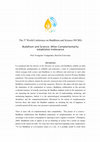
Introduction It is proposed that the rhetoric of the discourse on science and Buddhism exhibits a... more Introduction It is proposed that the rhetoric of the discourse on science and Buddhism exhibits an often non-deliberate predisposition to establish and perpetuate a kind of compartmentalization which consigns both science and Buddhism to two different and irrelevant to each other realms in the minds of the wider, general, and non-scientifically involved Western Buddhist population. This emerges non-deliberately, for the purpose of avoiding any essential influence between the two subjects, despite the sincerely expressed aims of the proponents of science— Buddhism complementarity to avoid that separation. However, this paper will also argue for the importance of the continuation of science—Buddhism collaboration as this provides evidential instances of actually practicing the Buddhist emphatic belief in the importance of not separating the pursuit of knowledge from the aim of understanding, producing, and maintaining happiness. Indeed, it is the epistemological incompatibility between the two disciplines, and the compartmentalization effectuated by the notion of complementarity between them, that makes the Buddhist emphasis on attaching the aim of happiness to scientific pursuit all the more real, persuasive and potentially imitable.
The Wounded Body in Literature. Taipei: Bookman, April 2012, Apr 2012
Mary Doria Russell's The Sparrow, and its sequel, Children of God, offer a glimpse at what may be... more Mary Doria Russell's The Sparrow, and its sequel, Children of God, offer a glimpse at what may be interpreted as the redeeming nature of participation in, and consequent suffering from, evil, not only from the obvious perspective of moral self-engagement but also within the context of epistemology, that is, the process of understanding our patterns of comprehension and knowledge when it comes to actively engaging in communication, exploration and analysis of questions of ultimate meaning. This paper begins with the consideration of The Sparrow's ability to explore the proposition of ultimate self degradation and disappointment as the enforced pathway to Enlightenment.
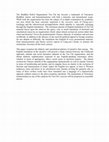
The Buddhist Relief Organization Tzu Chi has become a trademark of Taiwanese Buddhist charity and... more The Buddhist Relief Organization Tzu Chi has become a trademark of Taiwanese Buddhist charity and humanitarianism with both a domestic and international scope. While both the organization has been the subject of in-depth examination by academia, one area which has been curiously neglected is the narrative style of Cheng-yen's teachings and the ethical/social presuppositions which underlie it, especially emerging through the English translations. The enormous amount of English translation of Tzu Chi material forces upon the observer the query: why so much translation of doctrinal and catechetical essays by an organization which values almost exclusively action rather than ritual and doctrine? Given the predominantly Chinese ethnicity of members and activism worldwide, in addition to the absence of any need for political appeal to foreign countries for any dispute or difficulty, the translation into English of every promotional material, from announcements and charity activity reports to Ceng-yen's books, to internet site testimonies, becomes all the more curious. This paper examines the didactic and catechetical patterns of narrative that emerge. The English translation of the narrative will present a sharp contrast between, the Confucian approach, attitude and social dynamics inherent in the Tzu Chi organization, and the absent dialectic sophistication expected of any English-speaking missionary effort, whether in terms of apologetics, ethics, social issues or doctrinal enquiry. The almost exclusively Chinese outlook of the organization (domestically as well as outside Taiwan) in terms of membership and morals, and its singular focus on charity to the exclusion of doctrine and minimization of ritual, makes the English text appear, at least to Western audiences, basic and direct in its catechetical tone, thereby inviting the question why so many of these written works have been translated into a language of a diametrically opposite cultural context to the above-mention catechism. The momentum of Taiwanese modernization as one of the catalysts for Tzu Chi's success will be proposed as a possible answer.
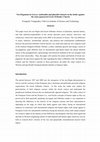
This paper traces the neo-Pagan and Greek Orthodox rhetoric of pluralism, national identiy, and s... more This paper traces the neo-Pagan and Greek Orthodox rhetoric of pluralism, national identiy, and state authority/responsibility in the various speeches, press releases, interviews, and conferences which have taken place from 2000 to the present in Greece. The vast difference in assets, influence, membership, doctrine, and political and constitutional establishment between the powerful Orthodox Church and the very small and relatively new religious trend of the Hellenic Religion (Elliniki Thriskia: a rather culturally-specific and unique version of neo-paganism, quite different from its international equivalent) makes the almost identical nature of the presuppositions, epistemology and rhetorical methods of the two unequal rivals all the more noteworthy. Thus, this paper will examine the nature and beliefs of Greek neo-paganism, the grievances against the state regarding the latter's affiliation with the Orthodox Church, and the Church's reaction to these grievances, all under the wider context of a Western and specifically European pluralist attitude to religious rights.
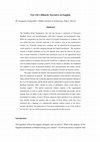
The Buddhist Relief Organization Tzu Chi has become a trademark of Taiwanese Buddhist charity and... more The Buddhist Relief Organization Tzu Chi has become a trademark of Taiwanese Buddhist charity and humanitarianism with both a domestic and international scope. While the organization has been the subject of in-depth examination by academia, one area which has been curiously neglected is the narrative style of the organization's founder, the Venerable Cheng-yen's teachings and the ethical/social presuppositions which underlie it, especially emerging through the English translations. The enormous amount of English translation of Tzu Chi material forces upon the observer the query: why so much translation of doctrinal and catechetical essays by an organization which values almost exclusively action rather than ritual and doctrine? Given the predominantly Chinese ethnicity of members and activism worldwide, in addition to the absence of any need for political appeal to foreign countries for any dispute or difficulty, the translation into English of every promotional material, from announcements and charity activity reports to Cheng-yen's books, to internet site testimonies, becomes all the more curious. This paper examines the didactic and catechetical patterns of narrative that emerge from the translations in question. The English translation of the narrative will present a sharp contrast between, the Confucian approach, attitude and social dynamics inherent in the Tzu Chi organization, and the absent dialectic sophistication expected of any English-speaking missionary effort, whether in terms of apologetics, ethics, social issues or doctrinal enquiry. The almost exclusively Chinese outlook of the organization (domestically as well as outside Taiwan) in terms of membership and morals, and its singular focus on charity to the exclusion of doctrine and minimization of ritual, makes the English text appear, at least to Western audiences, basic and direct in its catechetical tone, thereby inviting the question why so many of these written works have been translated into a language of a diametrically opposite cultural context to the above-mention catechism. The momentum of Taiwanese modernization as one of the catalysts for Tzu Chi's success will be proposed as one among the possible answers.
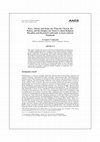
Asia Journal for Global Studies, 2009
This paper considers the process of doctrinal reinterpretation and rhetorical conformity to globa... more This paper considers the process of doctrinal reinterpretation and rhetorical conformity to globalization-driven changes in socio-cultural standards. Considered are the Virgin Mary, Kuan-yin, and Athena in the context of gender equality. Being an impersonal, non-negotiable state of affairs rather than a political system that might be negotiated with, globalization leaves no choice for exclusivist groups than to modify their rhetoric to maintain their relevance and exclusivity within globalized environments. In this context, pluralism may be served better when it ensures the prosperity and exclusivity of religious groups than when it stands as a moral axiom. The consideration of the three "goddesses" demonstrates the importance of the flexibility of doctrinal interpretation in view of the goal to maintain, amid the ever-changing, globalized context, the myth of noble origins and of a unified, continuous tradition founded on supposedly ever-relevant and immutable truths.
Drafts by Van Voulgarakis
Critical thinking can be defined as the scrutinising and evaluative attitude toward any claims to... more Critical thinking can be defined as the scrutinising and evaluative attitude toward any claims to factuality or accuracy This attitude questions final conclusions, syllogistic methods, and research procedures. Critical thinking is the kind of questioning that demands both proof of veracity/accuracy, and detail and transparency of each and every syllogistical and investigative step along the way.
The facts, so far: 1. It is not an ideology, but it is attached to one (Mudde's "thin ideology") ... more The facts, so far: 1. It is not an ideology, but it is attached to one (Mudde's "thin ideology") and has no defining parameters But what is attached to an ideology? Not helpful, thus far.
Conference Presentations by Van Voulgarakis
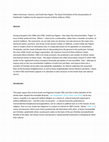
Having emerged in the 1980s and 1990s, Greek neo-Pagans—who reject the characterization " Pagan "... more Having emerged in the 1980s and 1990s, Greek neo-Pagans—who reject the characterization " Pagan " in favor of their preferred term, " Ethnic " —claim to be a continuation, rather than a romantic recreation, of ancient traditions. The movement, we are told, lacks any doctrine, but only preserves the major (non-doctrinal) axioms, practices, and virtues of the ancient Greeks, or Hellenes, a name Greek neo-Pagans claim in modern times for themselves only; it is especially known for its opposition to monotheism, Christianity, and the Greek Orthodox Church (descending from the general to the particular). Perhaps the most visible Greek neo-Pagan organization, the Supreme Council of Ethnic Hellenes (Ypato Symvoulio Ellinon Ethnikon, YSEE in its Greek acronym), has produced a vast number of articles, books, and internet entries on these issues. This paper examines the rather procrustean manner in which YSEE, similar to the eighteenth century European Orientalist perception of one monolithic "East," attempts to impose unity on the non-monotheistic traditions of both East and West, and impress them into a narrative of Christian persecution and capitalistic exploitation. Its rhetoric implicates the purported flaws of the European Enlightenment, as well as those of globalization-driven Western pluralism—values to which YSEE nevertheless appeals in its attempts to exert pressure on the Greek State and national church.
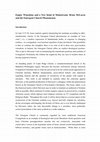
Is the Emergent Church phenomenon a modern expression of fundamental truths, in response to chang... more Is the Emergent Church phenomenon a modern expression of fundamental truths, in response to changing realities—or a misguided, even heretical repetition of past deviations? One possibility is that, to continue the Luke 5:37-38, metaphor (Jesus cautions against interpreting his teachings according to older, anachronistic criteria), there is no wine at all in these new, post-modern wineskins: at the bottom, the Emergent Church offers no explicit theological position. This is due to McLaren’s aim at maintaining the mainstream positions and symbols of Evangelical Christianity but without the negativity they are seen in modern times as having acquired in history.
This work is not intended to examine either the criticisms against McLaren, or the parallel productions of McLaren’s colleagues within the phenomenon known as the Emergent Church or Post-modern Christianity. The focus, rather, is on the rhetorical tactics which McLaren uses in order to maintain as unaltered a Christian faith as possible, albeit sanitized of certain negative aspects as perceived by a modern American society which opposes such religious extremes as TV evangelism and the Religious Right. Throughout this work it will be shown that no essential aspect of the exclusivism of the Christian symbols (e.g., heaven and hell, original sin, salvation, divine sovereignty and kingship, the divinity of Christ, etc) is ever directly challenged by McLaren; rather, the only discernible change is a smoother, more politically correct presentation of the same symbols to a wider audience.
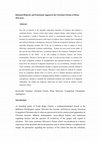
The role of emotion in the mutually supporting categories of literature and religion is commonly ... more The role of emotion in the mutually supporting categories of literature and religion is commonly known. Literary writers often explore religious themes, while religious systems have produced a wealth of literature for artistic or entertainment purposes. The use of literature for emotional persuasion with respect to religious aims is familiar from evangelism and political lobbying. Contemporary fiction by Protestant Evangelical apologists offers an especially intriguing example, that of the use of sentiment in order to appeal to reason following a purportedly academic methodology. Perhaps the most noted recent author of this type has been Brian McLaren, a prominent figure in the American " Emergent Church " phenomenon of the 2000s. In an odd coupling of scholarly analysis and literary sentimentality, McLaren's fiction aims at a type of social activism which—in contrast with the usual evangelistic methods of misapplication and misrepresentation of academia—is received by the American Evangelical mainstream as a set of rebellious, extremely liberal, overly academic, and confrontational attempts to appease post-modern cynicism. Draped in the post-modern garb of emotive fiction, McLaren's work cannot be reduced to a literary focus on evangelistic themes (like C.S. Lewis), nor to a modern rhetorical expression of fundamental truths in response to changing realities. Rather, it manifests as a sincere (if self-contradictory) attempt to maintain the mainstream positions and symbols of Evangelical Christianity, but without the negativity which they are often viewed by modern, secular American culture.
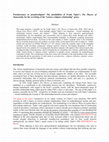
This paper proposes a possible use for Frank Tipler's The Physics of Immortality (POI, 1993) and ... more This paper proposes a possible use for Frank Tipler's The Physics of Immortality (POI, 1993) and its Omega Point Theory (OPT) – most probably against Tipler's own intentions – toward redefining " the relationship between science and religion. " While adhering to their respective epistemological methodologies, the two disciplines may occasionally seek to express their tenets through each other's terminology without compromising their non-negotiable principles, or arbitrarily assigning procrustean interpretations between them. Necessary to this, and contrary to Tipler's original vision. is the realization that no scientific progress but only aesthetic or artistic utility can be gained from such an endeavor. Unlike similar past practices as William Whiston's (17-18 th century) where the scientific aspect of the attempted synthesis would inevitably compromise religious doctrine whenever fact-finding demanded it, OPT is argued herein to be capable of (1) keeping both disciplines separate with regard to their inherent goals, thus avoiding the label of pseudoscience, and (2) bringing the two disciplines into a literary collaboration which, unlike science-fiction or religious writers' references to popular science, maintains the methodological constraints of both. The consideration of the above areas will contribute to the understanding of the various sociologically-driven perceptions of such terms as pseudoscience, religious orthodoxy, popular science, and science fiction and New Atheism.











Uploads
Papers by Van Voulgarakis
Scholars and public intellectuals disagree as to how far back to trace this process. Thomas Friedman (1999, 2005) focuses primarily on the end of the Cold War, and the technological and managerial developments of the 1990s. Benjamin Barber (1992) looks to the post-World War II rise of multinational corporations and international trade regimes (such as the Bretton Woods institutions and the various common markets). Paul Hirst and Grahame Thompson (1996) liken this to earlier cycles of internationalization, such as the period 1870-1914. William H. McNeill (1963) emphasizes the period of European industrialization and colonialism from 1750 to 1950. Immanuel Wallerstein (1974, 1980, 1989) begins with the great age of European exploration, and the intercontinental maritime empires established in its wake. Janet Abu-Lughod (1991) and Jack Weatherford (2004) hail the contributions of the thirteenth-century pax Mongolica. Others nominate the Umayyad and Abbasid Caliphates (e.g. Stearns, Adas, Schwartz & Gilbert, 2004), or earlier land-based Eurasian empires associated with the Silk Road. Andre Gunder Frank and Barry K. Gills (1991, 1993) suggest a figure of “five thousand years” ago, referring to trade ties between the Sumerian and Harappan civilizations. Daniel Quinn (1992) and Jared Diamond (1997) point to the development of mass agriculture some 10,000 years ago. Finally, James Harrod (2006) refers to “periods of globalization” during the Lower Paleolithic, between 1.9 and 1.6 million years ago, in which Olduwan industries (and presumably also the hominins themselves) spread out of Africa across Asia via the Indian Ocean.
Of course there is some merit to each of these starting points, at least within specifically defined contexts, and numerous attempts at periodization (some by the same authors). Here we may usefully resort to David Held’s distinction between “thick” globalization (characterized by high extensity, intensity, velocity, and impact) and several earlier forms. For example, the ancient Silk Road (which combined high extensity with low intensity, velocity, and impact) would be an example of “thin” globalization (Held, McGrew, Goldblatt, and Perraton, 1999; see also Nye, 2002). At any rate, the present momentum – for better or worse, and regardless of the system’s ultimate success or failure – is clearly in the direction of thickness. Less amenable to reconciliation are the questions of whether our era is unique, or part of some larger economic or historical cycle; and whether neoliberal economic policies will, or should, prevail under the New World Order.
Drafts by Van Voulgarakis
Conference Presentations by Van Voulgarakis
This work is not intended to examine either the criticisms against McLaren, or the parallel productions of McLaren’s colleagues within the phenomenon known as the Emergent Church or Post-modern Christianity. The focus, rather, is on the rhetorical tactics which McLaren uses in order to maintain as unaltered a Christian faith as possible, albeit sanitized of certain negative aspects as perceived by a modern American society which opposes such religious extremes as TV evangelism and the Religious Right. Throughout this work it will be shown that no essential aspect of the exclusivism of the Christian symbols (e.g., heaven and hell, original sin, salvation, divine sovereignty and kingship, the divinity of Christ, etc) is ever directly challenged by McLaren; rather, the only discernible change is a smoother, more politically correct presentation of the same symbols to a wider audience.
Scholars and public intellectuals disagree as to how far back to trace this process. Thomas Friedman (1999, 2005) focuses primarily on the end of the Cold War, and the technological and managerial developments of the 1990s. Benjamin Barber (1992) looks to the post-World War II rise of multinational corporations and international trade regimes (such as the Bretton Woods institutions and the various common markets). Paul Hirst and Grahame Thompson (1996) liken this to earlier cycles of internationalization, such as the period 1870-1914. William H. McNeill (1963) emphasizes the period of European industrialization and colonialism from 1750 to 1950. Immanuel Wallerstein (1974, 1980, 1989) begins with the great age of European exploration, and the intercontinental maritime empires established in its wake. Janet Abu-Lughod (1991) and Jack Weatherford (2004) hail the contributions of the thirteenth-century pax Mongolica. Others nominate the Umayyad and Abbasid Caliphates (e.g. Stearns, Adas, Schwartz & Gilbert, 2004), or earlier land-based Eurasian empires associated with the Silk Road. Andre Gunder Frank and Barry K. Gills (1991, 1993) suggest a figure of “five thousand years” ago, referring to trade ties between the Sumerian and Harappan civilizations. Daniel Quinn (1992) and Jared Diamond (1997) point to the development of mass agriculture some 10,000 years ago. Finally, James Harrod (2006) refers to “periods of globalization” during the Lower Paleolithic, between 1.9 and 1.6 million years ago, in which Olduwan industries (and presumably also the hominins themselves) spread out of Africa across Asia via the Indian Ocean.
Of course there is some merit to each of these starting points, at least within specifically defined contexts, and numerous attempts at periodization (some by the same authors). Here we may usefully resort to David Held’s distinction between “thick” globalization (characterized by high extensity, intensity, velocity, and impact) and several earlier forms. For example, the ancient Silk Road (which combined high extensity with low intensity, velocity, and impact) would be an example of “thin” globalization (Held, McGrew, Goldblatt, and Perraton, 1999; see also Nye, 2002). At any rate, the present momentum – for better or worse, and regardless of the system’s ultimate success or failure – is clearly in the direction of thickness. Less amenable to reconciliation are the questions of whether our era is unique, or part of some larger economic or historical cycle; and whether neoliberal economic policies will, or should, prevail under the New World Order.
This work is not intended to examine either the criticisms against McLaren, or the parallel productions of McLaren’s colleagues within the phenomenon known as the Emergent Church or Post-modern Christianity. The focus, rather, is on the rhetorical tactics which McLaren uses in order to maintain as unaltered a Christian faith as possible, albeit sanitized of certain negative aspects as perceived by a modern American society which opposes such religious extremes as TV evangelism and the Religious Right. Throughout this work it will be shown that no essential aspect of the exclusivism of the Christian symbols (e.g., heaven and hell, original sin, salvation, divine sovereignty and kingship, the divinity of Christ, etc) is ever directly challenged by McLaren; rather, the only discernible change is a smoother, more politically correct presentation of the same symbols to a wider audience.